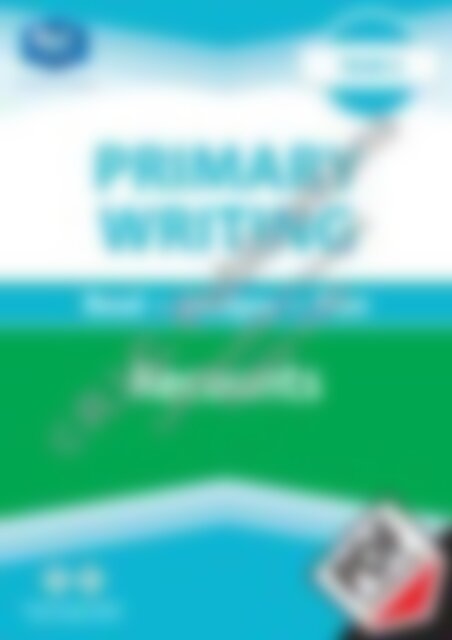RIC-20211 Primary Writing Year 5 – Recounts
Create successful ePaper yourself
Turn your PDF publications into a flip-book with our unique Google optimized e-Paper software.
©R.I.C. Publications<br />
Low Resolution Images<br />
Display Copy
PRIMARY WRITING (Book F)<br />
Published by R.I.C. Publications ® 2006<br />
Copyright © R.I.C. Publications ® 2006<br />
This master may only be reproduced by the<br />
original purchaser for use with their class(es). The<br />
publisher prohibits the loaning or onselling of this<br />
master for the purposes of reproduction.<br />
<strong>RIC</strong><strong>–</strong><strong>20211</strong><br />
Copyright Notice<br />
Blackline masters or copy masters are published and<br />
sold with a limited copyright. This copyright allows<br />
publishers to provide teachers and schools with a<br />
wide range of learning activities without copyright<br />
being breached. This limited copyright allows the<br />
purchaser to make sufficient copies for use within<br />
their own education institution. The copyright is not<br />
transferable, nor can it be onsold. Following these<br />
instructions is not essential but will ensure that you,<br />
as the purchaser, have evidence of legal ownership<br />
to the copyright if inspection occurs.<br />
For your added protection in the case of copyright<br />
inspection, please complete the form below. Retain<br />
this form, the complete original document and the<br />
invoice or receipt as proof of purchase.<br />
Name of Purchaser:<br />
Date of Purchase:<br />
Supplier:<br />
School Order# (if applicable):<br />
Signature of Purchaser:<br />
©R.I.C. Publications<br />
Low Resolution Images<br />
Display Copy<br />
Internet websites<br />
In some cases, websites or specific URLs may be recommended. While these are checked and rechecked at the<br />
time of publication, the publisher has no control over any subsequent changes which may be made to webpages.<br />
It is strongly<br />
recommended that the class teacher checks<br />
all<br />
URLs before allowing students to access them.<br />
View all pages online<br />
PO Box 332 Greenwood Western Australia 6924<br />
Website: www.ricgroup.com.au<br />
Email: mail@ricgroup.com.au
<strong>Primary</strong> writing<br />
BOOK F<br />
Foreword<br />
<strong>Primary</strong> writing<br />
is a series of seven books designed to provide opportunities for<br />
students to read, examine and write a variety of text types; narratives, recounts,<br />
procedures, reports, explanations and expositions.<br />
Contents<br />
Titles in this series:<br />
• <strong>Primary</strong> writing<br />
Book A<br />
• <strong>Primary</strong> writing<br />
Book B<br />
• <strong>Primary</strong> writing<br />
Book C<br />
• <strong>Primary</strong> writing<br />
Book D<br />
•<br />
<strong>Primary</strong> writing<br />
Book E<br />
•<br />
<strong>Primary</strong> writing<br />
Book F<br />
•<br />
<strong>Primary</strong> writing<br />
Book G<br />
Teachers notes .......................................................................................iv <strong>–</strong> v<br />
Curriculum links ............................................................................................ v<br />
<strong>Writing</strong> format information ....................................................................vi <strong>–</strong> vii<br />
<strong>Writing</strong> format checklists .....................................................................viii <strong>–</strong> xiii<br />
Blank writing formats ......................................................................... xiv <strong>–</strong> xix<br />
Proofreading and editing checklist ............................................................. xx<br />
Class recording sheet .................................................................................xxi<br />
Narratives ................................................................................................................2<strong>–</strong>13<br />
1 <strong>–</strong> Resistance ......................................................................................... 2<strong>–</strong>5<br />
2 <strong>–</strong> Accidental find ................................................................................... 6<strong>–</strong>9<br />
3 <strong>–</strong> Costume drama ............................................................................. 10<strong>–</strong>13<br />
<strong>Recounts</strong> ..............................................................................................................14<strong>–</strong>25<br />
1 <strong>–</strong> A very strange creature .................................................................. 14<strong>–</strong>17<br />
2 <strong>–</strong> Email to Dylan ................................................................................ 18<strong>–</strong>21<br />
3 <strong>–</strong> The journal of a Chinese gold digger ..............................................22<strong>–</strong>25<br />
Procedures ..............................................................................................................26<strong>–</strong>37<br />
1 <strong>–</strong> Baked lemon and ginger snapper ..................................................26<strong>–</strong>29<br />
2 <strong>–</strong> Ladybirds ........................................................................................30<strong>–</strong>33<br />
3 <strong>–</strong> Battleships ..................................................................................... 34<strong>–</strong>37<br />
Reports ..............................................................................................................38<strong>–</strong>49<br />
©R.I.C. Publications<br />
Low Resolution Images<br />
Display Copy<br />
1 <strong>–</strong> Problems with plastic ..................................................................... 38<strong>–</strong>41<br />
2 <strong>–</strong> The circulatory system ................................................................... 42<strong>–</strong>45<br />
3 <strong>–</strong> Antarctic experience ...................................................................... 46<strong>–</strong>49<br />
Explanations ..............................................................................................................50<strong>–</strong>61<br />
1 <strong>–</strong> The human voice ........................................................................... 50<strong>–</strong>53<br />
2 <strong>–</strong> Compact discs ............................................................................... 54<strong>–</strong>57<br />
3 <strong>–</strong> Peckish plants ............................................................................... 58<strong>–</strong>61<br />
Expositions ..............................................................................................................62<strong>–</strong>73<br />
1 <strong>–</strong> Class captain ................................................................................. 62<strong>–</strong>65<br />
2 <strong>–</strong> Riverside Park ............................................................................... 66<strong>–</strong>69<br />
3 <strong>–</strong> Jumping Jiminy! What a journal! .................................................... 70<strong>–</strong>73<br />
PRIMARY WRITING<br />
R.I.C. Publications<br />
www.ricgroup.com.au<br />
iii
<strong>Writing</strong> format information<br />
Below are general descriptions of the text types included in this book.<br />
Report<br />
<strong>–</strong> is a framework which describes aspects of a<br />
living or non-living thing in detail<br />
<strong>–</strong> includes:<br />
• Title<br />
• Classification: a general or classifying<br />
statement<br />
• Description: accurate and detailed<br />
• Conclusion: a comment about the content<br />
of the report (optional)<br />
<strong>–</strong> uses the following language features:<br />
• factual language rather than imaginative<br />
• the third person<br />
• the timeless present tense<br />
• information organised into paragraphs<br />
A report may be written in the form of a book<br />
review, scientifi c report, newspaper or magazine<br />
article, eyewitness account or a progress report.<br />
Recount<br />
<strong>–</strong> is a framework which retells events as they<br />
happened in time order<br />
<strong>–</strong> may be factual, personal or imaginative<br />
<strong>–</strong> includes:<br />
• Title<br />
• Orientation: all relevant background (who,<br />
when, where, why)<br />
• Events: signifi cant events in detail<br />
• Conclusion: often with an evaluative<br />
comment<br />
<strong>–</strong> uses the following language features:<br />
• vocabulary to suggest time passing<br />
• paragraphs to show separate sections<br />
• the past tense<br />
A recount may be written in the form of<br />
a newspaper report, diary, letter, journal,<br />
eyewitness account, biography, autobiography or<br />
history.<br />
Narrative<br />
<strong>–</strong> is a framework which tells a story<br />
<strong>–</strong> includes:<br />
• Title<br />
• Orientation: the setting, time and characters<br />
• Complication: involving the main character(s)<br />
and a sequence of events<br />
• Resolution: to the complication<br />
• Conclusion: often showing what has<br />
changed and what the characters have learnt<br />
<strong>–</strong> uses the following language features:<br />
• a range of conjunctions to connect ideas<br />
• appropriate paragraphing<br />
• descriptive language<br />
• usually written in past tense<br />
A narrative may be written in the form of a poem,<br />
story, play, imaginative story, fairytale, novel, myth,<br />
legend, ballad, science fi ction story or modern<br />
fantasy.<br />
Procedure<br />
<strong>–</strong> is a framework which outlines how something is<br />
made or done<br />
<strong>–</strong> includes:<br />
• Title<br />
• Goal: the purpose of the procedure shown<br />
clearly and precisely<br />
• Materials: a list of materials or requirements<br />
under appropriate headings or layout<br />
• Steps: the method in a detailed, logical<br />
sequence<br />
©R.I.C. Publications<br />
Low Resolution Images<br />
Display Copy<br />
• Test: an evaluation (if appropriate)<br />
<strong>–</strong> uses the following language features:<br />
• instructions often with an imperative verb<br />
• subject-specifi c vocabulary<br />
• simple present tense<br />
• concise language<br />
A procedure may be written in the form of a recipe,<br />
instructions for making something, an experiment,<br />
an instruction manual, a maths procedure, how to<br />
play a game, how to operate an appliance, how to<br />
use an atlas or how to deal with a problem.<br />
vi<br />
R.I.C. Publications<br />
www.ricgroup.com.au<br />
PRIMARY WRITING
<strong>Writing</strong> format information<br />
Explanation<br />
<strong>–</strong> is a framework which outlines how something occurs,<br />
works or is made<br />
<strong>–</strong> includes:<br />
• Title<br />
• Statement: precisely what is to be explained<br />
• Explanation: a clear account in logical sequence of<br />
how and why the phenomenon occurs<br />
• Conclusion: an evaluation and comment about<br />
what has been explained<br />
OR<br />
• Title<br />
• a definition<br />
• a description of the components or parts<br />
• the operation—how it works or is made<br />
• the application—where and when it works or is<br />
applied<br />
• special features—interesting comments<br />
• evaluation or comment/conclusion<br />
<strong>–</strong> uses the following language features:<br />
• subject-specifi c terms and technical vocabulary<br />
where appropriate<br />
• simple present tense is often used<br />
• linking words to show cause and effect<br />
• information is organised into paragraphs<br />
An explanation may be written in the form of an essay, or<br />
a handbook—for example, how a kite works—a science,<br />
health or society and environment text.<br />
Exposition<br />
<strong>–</strong> is a framework which argues for a<br />
particular position and attempts to<br />
persuade the audience to share this<br />
view<br />
<strong>–</strong> includes:<br />
• Title<br />
• Overview: statement of the problem<br />
or issue and the writer’s position<br />
• Arguments: presented in a logical<br />
manner with supporting detail,<br />
usually from the strongest to the<br />
weakest<br />
• Conclusion: a restating of the<br />
writer’s position and a summary of<br />
the arguments presented<br />
<strong>–</strong> uses the following language features:<br />
• a variety of controlling and emotive<br />
words and conjunctions<br />
• paragraphs to state and elaborate on<br />
each point<br />
An exposition may be written in the form<br />
of an essay, a letter, policy statement,<br />
a critical review, an advertisement, an<br />
editorial or a speech.<br />
©R.I.C. Publications<br />
Low Resolution Images<br />
Display Copy<br />
Modelled writing<br />
The role of the teacher is to observe and support students as they develop as writers.<br />
<strong>Writing</strong> is an extremely complex activity, simultaneously involving decisions on content,<br />
text coherence and cohesion, spelling, grammar, punctuation and a sense of audience and<br />
purpose. Because it takes time and practice to develop understanding of the writing process<br />
and the different writing formats, many opportunities for students to interact with their teacher<br />
and their peers are essential.<br />
Modelled writing is an effective way of supporting student writers, particularly when the focus<br />
is on the cognitive processes involved.<br />
Frequent modelling of the planning process and how these plans can be used to write text in<br />
different formats, is strongly recommended.<br />
PRIMARY WRITING<br />
R.I.C. Publications<br />
www.ricgroup.com.au<br />
vii
Proofreading and editing checklist<br />
Name: Date:<br />
Title:<br />
Punctuation:<br />
I have included:<br />
Spelling:<br />
Text type:<br />
capital letters for:<br />
beginning sentences. ..............................................................................................................<br />
proper nouns. ..........................................................................................................................<br />
titles .........................................................................................................................................<br />
question marks. ..................................................................................................................................<br />
full stops. .............................................................................................................................................<br />
commas<br />
in lists . ....................................................................................................................................<br />
for pauses . .............................................................................................................................<br />
to make meaning clear ...........................................................................................................<br />
apostrophes:<br />
for grammatical contractions. ..................................................................................................<br />
to show ownership. .................................................................................................................<br />
exclamation marks. .............................................................................................................................<br />
quotation marks. .................................................................................................................................<br />
colons<br />
in titles ....................................................................................................................................<br />
for offset lists ..........................................................................................................................<br />
brackets .............................................................................................................................................<br />
hyphens .............................................................................................................................................<br />
I have:<br />
checked the spelling of any unknown words. ..........................................................................<br />
not confused words that sound the same. ..............................................................................<br />
used correct endings for plurals. .............................................................................................<br />
Language features:<br />
<strong>Writing</strong>:<br />
I have included:<br />
a variety of different verbs. ......................................................................................................<br />
correct verb tenses. ................................................................................................................<br />
correct verb-subject agreement. .............................................................................................<br />
appropriate adverbs to describe verbs. ...................................................................................<br />
suitable nouns ........................................................................................................................<br />
appropriate pronouns ..............................................................................................................<br />
interesting adjectives ..............................................................................................................<br />
suitable conjunctions ...............................................................................................................<br />
a variety of prepositions ..........................................................................................................<br />
appropriate paragraphing. .......................................................................................................<br />
no double negatives ................................................................................................................<br />
©R.I.C. Publications<br />
Low Resolution Images<br />
Display Copy<br />
I have read through my writing to check that:<br />
it makes sense. .......................................................................................................................<br />
it is easy to understand. ..........................................................................................................<br />
there are no repeated or omitted words. .................................................................................<br />
there are no errors of fact. ......................................................................................................<br />
xx<br />
R.I.C. Publications<br />
www.ricgroup.com.au<br />
PRIMARY WRITING
1 <strong>Recounts</strong><br />
TEACHERS NOTES<br />
Structural and language features are shown on the left and right of the text below.<br />
Title<br />
Orientation <strong>–</strong><br />
who, when, where,<br />
why<br />
Events <strong>–</strong><br />
signifi cant events in<br />
detail<br />
Conclusion <strong>–</strong><br />
often with an<br />
evaluative comment<br />
A very strange creature<br />
I saw the most amazing thing when I walked home from training yesterday! Sasha<br />
and I had just reached the corner of our street when we saw a crowd of people<br />
looking up into the trees along the footpath.<br />
We had to stop and fi nd out what was so interesting, so we moved through the<br />
crowd until we got close to the front where we had a better view.<br />
Sitting happily in the branches of one of the trees was the strangest creature I had<br />
ever seen! It was only about as big as my school ruler and had a pink face. It had<br />
yellow hands and feet. The fur on its back was grey and it had black fur around<br />
its mouth and nose. It even had tufts of white fur on its ears! Leaves shook as it<br />
scrambled madly backwards and forwards among the branches. Twittering and<br />
shrieking noises could be heard coming from behind the leaves.<br />
The crowd chatted to each other and pointed at the creature.<br />
Old Mrs Tonkins and Mr Dial carried out a lively discussion about what type of<br />
creature it was and whether it was dangerous, while others muttered that Robert<br />
needed to be quick about ringing the animal protection board.<br />
We all kept our eyes on the creature while we waited, afraid that it might disappear<br />
before help could arrive.<br />
After about twenty minutes, a truck could be heard coming up the street. We all<br />
stepped out of the way and watched two men emerge. They went to the back of<br />
the truck and got out a wire cage, a large net and a ladder and harness.<br />
The smallest man propped the ladder against the nearest tree and quietly climbed<br />
into the lower branches. Once he was seated safely in the fork of the tree, he<br />
attached the harness to a strong branch. His partner passed the net up to him and<br />
he manoeuvred it until it was over the top of the creature. When he brought it swiftly<br />
down, trapping the creature between the net and a tree branch. Then he slipped<br />
the net underneath and around the creature and handed it down to his partner. He<br />
pushed the opening of the net into the cage and released the creature.<br />
‘It’s great that you people saw this little fellow’, he stated. ‘Someone climbed over<br />
the zoo fence last night and let out all the monkeys. We’ve been collecting them all<br />
day. These spider monkeys have only just arrived from South America for our breeding<br />
program. They’re the sweetest specimens I’ve ever seen!’<br />
Teacher information<br />
• This recount is written in the form of an eyewitness account.<br />
• Allow the students to read the recount or choose individual<br />
students to read selected sections.<br />
• Discuss the recount, asking students questions to help<br />
them identify the title, orientation, some events and the<br />
conclusion.<br />
• Discuss specifi c language features such as verbs in<br />
the past tense, vocabulary to suggest time passing and<br />
paragraphs to show separate sections. Students should<br />
indicate examples of each.<br />
• Allow students to complete the analysis on page 16.<br />
• Model the process of planning and writing a recount about<br />
a recent school activity such as an assembly or sporting<br />
activity. Model writing it as though it were an eyewitness<br />
account. Include all language features indicated above.<br />
• Ensure students know that the plan is to record ideas only<br />
and the actual writing of the recount will come later.<br />
• Students use page 17 to plan a recount of an unusual event<br />
they have witnessed.<br />
• Students write their recounts, which could be included in a<br />
class newspaper for display in the school library for other<br />
classes to read. (Purpose/Audience/Display)<br />
• A recount of this nature could be written following a<br />
discussion about newspapers and communication. Students<br />
could rewrite newspaper accounts as interesting recounts.<br />
(Context)<br />
• Verbs in the<br />
past tense;<br />
e.g. saw,<br />
walked<br />
• paragraphs<br />
to show<br />
different<br />
sections<br />
• vocabulary<br />
to suggest<br />
passing of<br />
time; e.g.<br />
After about<br />
twenty<br />
minutes,<br />
Then<br />
Answers<br />
Page 16<br />
1-2. Teacher check<br />
3. (a) Teacher check<br />
(b) Answers will vary but the capture of the monkey is<br />
given in great detail.<br />
(c) Answers will include ‘propped’, ‘climbed’, ‘was seated’,<br />
‘attached’, ‘passed’, ‘manoeuvred’, ‘was’, ‘brought’,<br />
slipped’, ‘handed’, ‘pushed’ and ‘released’.<br />
4. The conclusion tells us that he thinks that the creatures are<br />
‘sweet’.<br />
©R.I.C. Publications<br />
Low Resolution Images<br />
Display Copy<br />
14 R.I.C. Publications www.ricgroup.com.au<br />
PRIMARY WRITING
A very strange creature<br />
I saw the most amazing thing when I walked<br />
home from training yesterday! Sasha and I had just<br />
reached the corner of our street when we saw a<br />
crowd of people looking up into the trees along the<br />
footpath.<br />
We had to stop and fi nd out what was so interesting,<br />
so we moved through the crowd until we got close<br />
to the front where we had a better view.<br />
Sitting happily in the branches of one of the trees<br />
was the strangest creature I had ever seen! It was<br />
only about as big as my school ruler and had a<br />
pink face. It had yellow hands and feet. The fur<br />
on its back was grey and it had black fur around<br />
its mouth and nose. It even had tufts of white fur<br />
on its ears! Leaves shook as it scrambled madly<br />
backwards and forwards among the branches.<br />
Twittering and shrieking noises could be heard<br />
coming from behind the leaves.<br />
The crowd chatted to each other and pointed at the<br />
creature.<br />
Old Mrs Tonkins and Mr Dial carried out a lively<br />
discussion about what type of creature it was and<br />
whether it was dangerous, while others muttered<br />
that Robert needed to be quick about ringing<br />
the animal protection board.<br />
We all kept our eyes on the creature<br />
while we waited, afraid that it might<br />
disappear before help could arrive.<br />
After about twenty minutes, a<br />
truck could be heard coming up<br />
the street. We all stepped out of<br />
the way and watched two men<br />
emerge. They went to the back<br />
of the truck and got out a wire<br />
cage, a large net and a ladder<br />
and harness.<br />
Recount 1<br />
The smallest man propped the ladder against the<br />
nearest tree and quietly climbed into the lower<br />
branches. Once he was seated safely in the fork<br />
of the tree, he attached the harness to a strong<br />
branch. His partner passed the net up to him and he<br />
manoeuvred it until it was over the top of the creature.<br />
When he brought it swiftly down, the creature was<br />
trapped between the net and a tree branch. Then he<br />
slipped the net underneath and around the creature<br />
and handed it down to his partner. He pushed the<br />
opening of the net into the cage and released the<br />
creature.<br />
‘It’s great that you people saw this little fellow’, he<br />
stated. ‘Someone climbed over the zoo fence last<br />
night and let out all the monkeys. We’ve been<br />
collecting them all day. These spider monkeys<br />
have only just arrived from South America for our<br />
breeding program. They’re the sweetest specimens<br />
I’ve ever seen!’<br />
©R.I.C. Publications<br />
Low Resolution Images<br />
Display Copy<br />
PRIMARY WRITING<br />
R.I.C. Publications<br />
www.ricgroup.com.au<br />
15
Use the recount on page 15 to complete the page.<br />
1. Title<br />
(a) Does this title clearly tell what the recount is<br />
about?<br />
yes<br />
no<br />
(b) Write another suitable title.<br />
Examining recount 1<br />
2. Orientation<br />
Write a brief sentence to substitute for the fi rst<br />
paragraph which tells ‘who’, ‘when’, ‘where’,<br />
‘why’ and ‘what’.<br />
3. Events<br />
(a) Use the boxes below to draw and sequence up to six main events which occurred. You may<br />
complete your drawings in cartoon form if you wish and include speech bubbles.<br />
©R.I.C. Publications<br />
Low Resolution Images<br />
Display Copy<br />
(b) Name one event which was described in great detail.<br />
(c) List six different verbs in the past tense in the second last paragraph.<br />
4. Conclusion<br />
What information does the conclusion give us about the man’s opinion of the ‘strange creatures’?<br />
16 R.I.C. Publications www.ricgroup.com.au<br />
PRIMARY WRITING
1. Plan a recount about an unusual event you have witnessed.<br />
Title<br />
Recount plan 1<br />
Orientation<br />
Who, when, where, why<br />
Events<br />
What things happened?<br />
Conclusion<br />
What happened at the end?<br />
©R.I.C. Publications<br />
Low Resolution Images<br />
Display Copy<br />
2. Write your recount. 3. Edit your work.<br />
PRIMARY WRITING<br />
R.I.C. Publications<br />
www.ricgroup.com.au<br />
17
2 <strong>Recounts</strong><br />
TEACHERS NOTES<br />
Structural and language features are shown on the left and right of the text below.<br />
Title<br />
Orientation <strong>–</strong><br />
who, when, where,<br />
why<br />
Events <strong>–</strong><br />
signifi cant events in<br />
detail<br />
Conclusion <strong>–</strong><br />
often with an<br />
evaluative comment<br />
Email to Dylan<br />
Hi Dylan<br />
Our plane was late leaving Heathrow on Saturday because of the bad weather.<br />
Brad and Lizzie were grumbling and whining by the time we fi nally got on the<br />
plane. They’re such little kids! Dad was really excited about his new job and Mum<br />
was looking forward to fi nally having a big house and some nice weather. Thank<br />
goodness the novelty of being on a plane quietened Brad and Lizzie down for a<br />
while until we landed in Singapore!<br />
By the time we arrived in Singapore we were all ready to stretch our legs. We spent<br />
the night in a really great hotel close to the airport. There was even a telephone in<br />
the bathroom! Unfortunately, we had to get up early to get on the plane to Australia.<br />
At least I got a window seat on the plane so it wasn’t as bad as the fi rst leg of the<br />
journey! I got to see ‘Kung fu king’, but I won’t tell you what the movie was about<br />
and spoil it for you! The food wasn’t too bad but I enjoyed the chocolate ice-cream<br />
the best! I was glad that I fi lled by backpack with comics and computer games as<br />
the trip seemed to go on forever. We were all getting tired of travelling by the time<br />
the pilot announced that we were making our descent.<br />
We fi nally arrived in Australia on Sunday afternoon. After we had all disembarked<br />
and collected our baggage, I was starting to worry again. I realised that it was going<br />
to be a big change coming from winter in England to summer in Australia. When we<br />
got out of the terminal, we could already feel how hot it was! It’s hard to believe it<br />
was cold and rainy when we left England.<br />
We caught a taxi to the motel where we are staying until our furniture arrives at the<br />
new house. Tomorrow, we’re taking a hire car to see where we’ll be living.<br />
Talk to you soon! Dad wants to use his laptop to email Grandma and Grandpa to let<br />
them know we arrived safely! When he’s fi nished, I’m going to ask him how hard it is<br />
to learn to ride a surfboard!<br />
Your ‘mate’, Evan!<br />
Teacher information<br />
• This recount is written in the form of an email. In order to<br />
include a number of events, this email is longer than many<br />
emails would be.<br />
• Select students to read parts or allow students to read the<br />
recount independently.<br />
• Discuss the recount, asking students questions to focus<br />
attention on the title, orientation, events and the conclusion.<br />
• Revise the language features which should be included,<br />
such as vocabulary to suggest the passing of time and<br />
verbs in the past tense.<br />
• Allow the students to complete the analysis on page 20,<br />
assisting where necessary.<br />
• Ensure that students know that the plan on page 21 is to<br />
record ideas only and the actual writing of the recount will<br />
come later.<br />
• Model the process of completing and using a plan to write<br />
a recount in the form of an email. Students may like to offer<br />
suggestions for a possible title, names of characters, events<br />
to include and an interesting comment for the conclusion.<br />
• Students may use bullet points with words or sentences to<br />
complete their plan (on page 21) of an email describing a<br />
recent event to a friend or relative.<br />
• Students could type and print their new recount using a<br />
computer and display it with a border suggesting an email<br />
format. (Publishing/Display)<br />
• Students could write their email recount to send to a<br />
member of another class at the school to inform them about<br />
a recent event. (Purpose/Audience)<br />
• Students use their recount in conjunction with a theme<br />
about communication or multiculturalism. (Context)<br />
• vocabulary<br />
to suggest<br />
passing of<br />
time; e.g. by<br />
the time, until<br />
• Verbs in the<br />
past tense;<br />
e.g. enjoyed,<br />
announced<br />
• paragraphs<br />
to show<br />
different<br />
sections<br />
Answers<br />
Page 20<br />
1. Teacher check<br />
2. (a) Teacher check<br />
(b) Evan’s name is at the end of the email.<br />
3. (a) looked out the window (implied), watched a movie, ate,<br />
read comics, played computer games<br />
(b) Teacher check<br />
4. ‘When he’s fi nished, I’m going to ask him how hard it is to<br />
learn to ride a surfboard!’<br />
©R.I.C. Publications<br />
Low Resolution Images<br />
Display Copy<br />
18 R.I.C. Publications www.ricgroup.com.au<br />
PRIMARY WRITING
Email to Dylan<br />
Recount 2<br />
Hi Dylan<br />
Our plane was late leaving Heathrow on Saturday because of the bad<br />
weather. Brad and Lizzie were grumbling and whining by the time we<br />
finally got on the plane. Theyʼre such little kids! Dad was really<br />
excited about his new job and Mum was looking forward to finally having<br />
a big house and some nice weather. Thank goodness the novelty of being<br />
on a plane quietened Brad and Lizzie down for a while until we landed in<br />
Singapore!<br />
By the time we arrived in Singapore we were all ready to stretch our<br />
legs. We spent the night in a really great hotel close to the airport.<br />
There was even a telephone in the bathroom! Unfortunately, we had to get<br />
up early to get on the plane to Australia. At least I got a window seat<br />
on the plane so it wasnʼt as bad as the first leg of the journey! I got<br />
to see ʻKung fu kingʼ, but I wonʼt tell you what the movie was about and<br />
spoil it for you! The food wasnʼt too bad but I enjoyed the chocolate<br />
ice-cream the best! I was glad that I filled my backpack with comics and<br />
computer games as the trip seemed to go on forever. We were all getting<br />
tired of travelling by the time the pilot announced that we were making<br />
our descent.<br />
We finally arrived in Australia on Sunday afternoon. After we had all<br />
disembarked and collected our baggage, I was starting to worry again.<br />
I realised that it was going to be a big change coming from winter in<br />
England to summer in Australia. When we got out of the terminal, we<br />
could already feel how hot it was! Itʼs hard to believe it was cold and<br />
rainy when we left England.<br />
We caught a taxi to the motel where we are staying until our furniture<br />
arrives at the new house. Tomorrow, weʼre taking a hire car to see where<br />
weʼll be living.<br />
Talk to you soon! Dad wants to use his laptop to email Grandma and<br />
Grandpa to let them know we arrived safely! When heʼs finished, Iʼm going<br />
to ask him how hard it is to learn to ride a surfboard!<br />
Your ʻmateʼ, Evan!<br />
©R.I.C. Publications<br />
Low Resolution Images<br />
Display Copy<br />
PRIMARY WRITING<br />
R.I.C. Publications<br />
www.ricgroup.com.au<br />
19
Use the recount on page 19 to complete the page.<br />
1. Title<br />
Write a new, appropriate<br />
title for the recount.<br />
2. Orientation<br />
An orientation gives the relevant information<br />
about ‘who’, ‘when’, ‘where’ and ‘why’.<br />
(a) Rewrite the fi rst paragraph as one sentence<br />
so that it includes all the information above.<br />
(b) One piece of information was not found in<br />
the orientation but at the end. What was it?<br />
4. Conclusion<br />
Which sentence tells that Evan may be feeling<br />
a bit more optimistic about the move from<br />
England to Australia?<br />
Examining recount 2<br />
3. Events<br />
(a) List fi ve different things Evan did on the<br />
plane. (One is implied!)<br />
(b) Write examples from the text for each of the<br />
boxes.<br />
Vocabulary which suggests the passing of time<br />
©R.I.C. Publications<br />
Low Resolution Images<br />
Display Copy<br />
Verbs in the past tense<br />
20 R.I.C. Publications www.ricgroup.com.au<br />
PRIMARY WRITING
Recount plan 2<br />
1. Plan a recount describing a recent event that you could email to a friend or relative living in another<br />
town, city or country. It need not be true!<br />
Title<br />
Orientation<br />
Who, when, where, why<br />
Events<br />
©R.I.C. Publications<br />
Low Resolution Images<br />
Display Copy<br />
Conclusion<br />
2. Write your recount. 3. Edit your work.<br />
PRIMARY WRITING<br />
R.I.C. Publications<br />
www.ricgroup.com.au<br />
21
3 <strong>Recounts</strong><br />
TEACHERS NOTES<br />
Structural and language features are shown on the left and right of the text below.<br />
Title<br />
Orientation <strong>–</strong><br />
who, when, where,<br />
why<br />
Events <strong>–</strong><br />
signifi cant events in<br />
detail<br />
Conclusion <strong>–</strong><br />
often with an<br />
evaluative comment<br />
The journal of a Chinese gold digger<br />
June 1, 1855<br />
Today, we arrived on the goldfi elds and found our camp. We set up our tent next to<br />
the others. We talked to some of the workers and found some who spoke the same<br />
dialect as us and discovered they were from our province.<br />
June 2,1855<br />
After<br />
our fi rst meal, we took our tools and headed for the diggings. We found a spot<br />
abandoned by the Europeans and started work in our team. It was hard but one of our<br />
team saw some chips in the debris so we kept working.<br />
June 3, 1855<br />
Some Europeans passed our claims today, yelling and calling out in threatening tones.<br />
I was glad that I couldn’t understand what they were saying, but I know that they<br />
didn’t like us being there! When we got back<br />
to our campsite, some of the tents were<br />
collapsed in a heap and cooking utensils and clothes were scattered around in the<br />
dirt. I don’t understand why they dislike us so much. We are only trying to make a living<br />
to look after our families. We don’t bother them so why should they bother us?<br />
December 14, 1855<br />
Today, I was able to send a small pouch of gold dust back to the trader who gave<br />
me the money to come to Australia. The last thing I want is for my family in China to<br />
become his slaves. I’m trying to make life better for my family — not worse! It’s really<br />
hard work to fi nd even a little bit of gold, but I’m used to living in poor conditions and<br />
not having very much. I can work as long as I need to.<br />
January 20, 1857<br />
The gold seems to be running out now. We have to keep moving to fi nd abandoned<br />
sites and to work longer hours for little reward. I have fi nally repaid my loan and some<br />
of my family have joined me. I have come to know this country well. A person can do<br />
well for himself if he is prepared to work hard.<br />
I would like to stay here and make a new life for myself and my family. I’m sure nothing<br />
could be as hard as digging for gold but maybe I’ll become a rich merchant myself<br />
one day!<br />
Teacher information<br />
• This recount is written in the form of a journal. This<br />
particular example doesn’t use specifi c names so the ‘who’<br />
in the orientation is ‘we’ and the ‘why’ is implied.<br />
• Read the recount with the students, select students to read<br />
parts or allow students to read the recount independently.<br />
• Discuss the recount, asking questions to help identify the<br />
title, the orientation, some events and the conclusion.<br />
• Allow the students to complete the analysis on page 24,<br />
offering assistance where necessary.<br />
• Ensure that students know that the plan is to record ideas<br />
only and the actual writing of the recount will come later.<br />
• Model the process of planning and writing a recount if<br />
students have not completed a plan before. A possible<br />
example would be to choose a character from a historical<br />
time studied during a SOSE theme such as Early<br />
Settlement in Australia or the recount of a time in the life of<br />
a person who comes from another country. Examples such<br />
as these will give students an understanding of the lives of<br />
other people in a different time or culture.<br />
• Students may write bullet points in the form of words or<br />
sentences to complete their plan on page 25.<br />
• Students could write recounts relating to a particular<br />
historical time to form the basis of roleplays to perform for<br />
the class. (Purpose/Audience)<br />
• Students write this recount when completing a theme<br />
about the early history of Australia or another country or<br />
multiculturalism. (Context)<br />
• Publish recounts in an ‘old-fashioned’ font and display with<br />
a detailed appropriate sketch or diagram. (Display)<br />
• Verbs in the<br />
past tense;<br />
e.g. spoke,<br />
discovered<br />
• vocabulary<br />
to suggest<br />
passing of<br />
time; e.g.<br />
After, When<br />
we got back<br />
• paragraphs<br />
to show<br />
different<br />
sections<br />
Answers<br />
Page 24<br />
1. Teacher check<br />
2. (a) (i) we<br />
(ii) June 1, 1855<br />
(iii) in our camp, on the goldfi elds<br />
(b) Teacher check<br />
3. (a) 3<br />
(b) 2<br />
(c) 1<br />
(d) 3<br />
(e) 3<br />
(f) 1<br />
4. This conclusion indicates that the Chinese gold miner may<br />
stay in Australia with his family and start a business and<br />
become a rich merchant as nothing could be as hard as<br />
digging for gold.<br />
©R.I.C. Publications<br />
Low Resolution Images<br />
Display Copy<br />
22 R.I.C. Publications www.ricgroup.com.au<br />
PRIMARY WRITING
Recount 3<br />
The journal of a Chinese gold digger<br />
June 1, 1855<br />
June 3, 1855<br />
Today, we arrived on the goldfi elds and found our<br />
camp. We set up our tent next to the others. We<br />
talked to some of the workers and found some<br />
who spoke the same dialect as us and discovered<br />
they were from our province.<br />
June 2, 1855<br />
After our fi rst meal, we took our tools and headed<br />
for the diggings. We found a spot abandoned by<br />
the Europeans and started work in our team. It was<br />
hard but one of our team saw some chips in the<br />
debris so we kept working.<br />
Some Europeans passed our claims today, yelling<br />
and calling out in threatening tones. I was glad<br />
that I couldn’t understand what they were saying,<br />
but I know that they didn’t like us being there!<br />
When we got back to our campsite, some of<br />
the tents were collapsed in a heap and cooking<br />
utensils and clothes were scattered around in the<br />
dirt. I don’t understand why they dislike us so<br />
much. We are only trying to make a living to look<br />
after our families. We don’t bother them so why<br />
should they bother us?<br />
December 14, 1855<br />
Today, I was able to send a small pouch of gold<br />
dust back to the trader who gave me the money to<br />
come to Australia. The last thing I want is for my<br />
family in China to become his slaves. I’m trying<br />
to make life better for my family—not worse! It’s<br />
really hard work to fi nd even a little bit of gold,<br />
but I’m used to living in poor conditions and not<br />
having very much. I can work as long as I need to.<br />
©R.I.C. Publications<br />
Low Resolution Images<br />
Display Copy<br />
January 20, 1857<br />
The gold seems to be running out now. We have to<br />
keep moving to fi nd abandoned sites and to work<br />
longer hours for little reward. I have fi nally repaid<br />
my loan and some of my family have joined me. I<br />
have come to know this country well. The climate<br />
is pleasant and a person can do well for himself if<br />
he is prepared to work hard.<br />
I would like to stay here and make a new life for<br />
myself and my family. I’m sure nothing could be<br />
as hard as digging for gold. Maybe I’ll become a<br />
rich merchant myself one day!<br />
PRIMARY WRITING<br />
R.I.C. Publications<br />
www.ricgroup.com.au<br />
23
Use the recount on page 23 to complete the page.<br />
1. Title<br />
(a) Tick the boxes.<br />
(i) the title is suitable<br />
(ii) the title supplies extra information<br />
(b) Write another appropriate title.<br />
3. Events<br />
The events in the recount give a vivid description of<br />
what life was like for a Chinese gold miner in<br />
Australia during the 1850s.<br />
Give the paragraph number of an event which<br />
tells:<br />
(a) Chinese gold miners borrowed<br />
money to come to Australia.<br />
(b) The Chinese were abused by the<br />
European miners.<br />
(c) The Chinese used sites abandoned<br />
by the Europeans.<br />
(d) The families of Chinese gold<br />
diggers who did not send gold<br />
back to repay their loan were taken<br />
as slaves by the wealthy traders.<br />
(e) Chinese miners were used to poor<br />
conditions, worked hard and were<br />
patient.<br />
(f) Chinese gold miners kept to<br />
themselves and worked in teams.<br />
Examining recount 3<br />
2. Orientation<br />
(a) Write words from the orientation which<br />
show:<br />
(i) Who?<br />
(ii) When?<br />
(iii) Where?<br />
(b) Use the information from the title, the<br />
orientation and ‘made-up’ names to write a<br />
sentence for a new orientation.<br />
4. Conclusion<br />
Many Chinese returned to their homeland after<br />
the gold rush. What does the conclusion tell you<br />
about this Chinese worker?<br />
©R.I.C. Publications<br />
Low Resolution Images<br />
Display Copy<br />
24 R.I.C. Publications www.ricgroup.com.au<br />
PRIMARY WRITING
Recount plan 3<br />
1. Select a character or historical fi gure from an interesting time you may have studied. Plan a recount in<br />
the form of a diary or journal which tells about that person’s life.<br />
Title<br />
Orientation<br />
Events<br />
©R.I.C. Publications<br />
Low Resolution Images<br />
Display Copy<br />
Conclusion<br />
2. Write your recount. 3. Edit your work.<br />
PRIMARY WRITING<br />
R.I.C. Publications<br />
www.ricgroup.com.au<br />
25
Blank writing format <strong>–</strong> Recount<br />
Title<br />
Orientation<br />
Who? Where? When? Why?<br />
Events<br />
©R.I.C. Publications<br />
Low Resolution Images<br />
Display Copy<br />
Conclusion<br />
PRIMARY WRITING<br />
R.I.C. Publications<br />
www.ricgroup.com.au<br />
xv
<strong>Writing</strong> format checklists<br />
Student recount checklist<br />
Student recount checklist<br />
Title:<br />
The title is suitable.<br />
Orientation:<br />
A clearly written orientation provides relevant<br />
information about who, when, where and why.<br />
Events:<br />
Signifi cant events are described in detail.<br />
Events are retold in chronological order.<br />
Conclusion:<br />
The ending is clearly described.<br />
An evaluative comment about the<br />
conclusion is included.<br />
<strong>Writing</strong> skills:<br />
Paragraphs are used to show separate sections.<br />
Title:<br />
The title is suitable.<br />
Orientation:<br />
A clearly written orientation provides relevant<br />
information about who, when, where and why.<br />
Events:<br />
Signifi cant events are described in detail.<br />
Events are retold in chronological order.<br />
Conclusion:<br />
The ending is clearly described.<br />
An evaluative comment about the<br />
conclusion is included.<br />
<strong>Writing</strong> skills:<br />
Paragraphs are used to show separate sections.<br />
Descriptive language is included.<br />
©R.I.C. Publications<br />
Low Resolution Images<br />
Display Copy<br />
Descriptive language is included.<br />
Vocabulary suggests the passing of time.<br />
The past tense is maintained.<br />
Sentence beginnings vary.<br />
Quotation marks are used for quoted speech.<br />
Punctuation and spelling have been checked.<br />
Vocabulary suggests the passing of time.<br />
The past tense is maintained.<br />
Sentence beginnings vary.<br />
Quotation marks are used for quoted speech.<br />
Punctuation and spelling have been checked.<br />
Name: Date:<br />
Name: Date:<br />
PRIMARY WRITING<br />
R.I.C. Publications<br />
www.ricgroup.com.au<br />
ix


















